Books by Dr. Marc Edmund Jones
Dr. Marc Edmund Jones was the founding chancellor of the Sabian Assembly. He was most widely known for his work in astrology, for his origination of the Sabian symbols in 1925, and for their later development. His background is unique. After dropping out of high school to go into business, he later completed his Ph.D. in philosophy from Columbia University in 1948. In his early days, he was a Hollywood screen writer, and was instrumental in founding the Screen Writers' Guild. In 1935, he received his Bachelor of Divinity degree at the San Francisco Theological Seminary at San Anselmo, California and was ordained as a Presbyterian minister. He served as a pastor in Esparto, California for five years.
Dr. Jones, or Marc, began studying astrology in 1913. In all, he authored twelve books on astrology and wrote twelve special astrology lesson sets for Sabian students. In later years, Marc was often called the Dean of American Astrology.
Books by Dr. Marc Edmund Jones
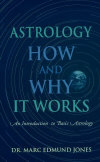
Astrology, How and Why it Works
This book is the most complete and yet the most simple exposition of houses, signs and planets of the horoscope. This book shows how astrology arose in the beginning from primitive man's experience, with the world of chance and risk in which he found himself, and how his descendants have been able to bring their destiny under their own control very materially by employing the moment of birth to locate themselves effectively in the orderliness of the universe. (Aurora Press, 1993).
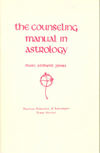
The Counseling Manual in Astrology
This is the last major work of Marc Edmund Jones, completed shortly before his death in 1980. It involves the most important part of the human science of astrology: counseling. Calling upon all the years of acquired knowledge, the learnings, the finer points of astrology, as presented in previous Sabian volumes, this manual presents the pinnacle of the art, opening new realms of understanding, and demonstrating a true master's technique. (American Federation of Astrologers, 1979).
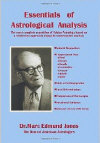
The Essentials of Astrological Analysis
Here is a wonderfully complete exposition of the astrological horoscope. It presents the whole-view approach to an understanding of human personality, in each absolutely unique pattern of potentials. By a fundamentally simple sifting out of the more pertinent factors of individual character, as astrology makes this practical, the baffling complexity of man's make-up is brought to an effective ordering. The method, by avoiding the confusion of needless side issues and irrelevant generalities, contributes to incisive analysis and facilitates exceptionally dependable advisement. (Trafford Publishing, 2001).
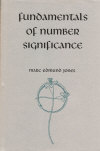
The Fundamentals of Number Significance
This book is an autobiographical account of what one individual has accomplished in bringing man's ancient astrology to a modern effectiveness. The story of the golden age of the horoscope in Greco-Roman times, with its decline into a tawdry fortunetelling and consequent virtual disappearance in the Christian world until its gradual renaissance in the late medieval period and its recent almost complete re-establishment in more respectable form, is told in interesting detail. (The Sabian Publishing Society and Shambhala Publications, 1978).
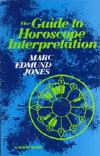
The Guide to Horoscope Interpretation
Here is an answer to the greatest problem of the beginner. Just how shall he start, in interpreting a horoscope? Actually all horoscopes can be divided into seven basic temperament types, often identifiable at a glance, and helping the astrologer get at the heart of a natal chart almost instantly. Similarly, the planets may have simple analysis according to the one of four basic departments of concern each indicates, so that even the novice may recognize a native's dynamic potentials rather quickly, and have special guidance in fundamental judgment. These few leading principles can bring all horoscopic indications into an overall consistency. (The Theosophical Publishing House, 1975).
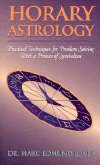
Horary Astrology: Practical Techniques for Problem Solving with a Primer of Symbolism
When the original edition was published in 1943, it was the first major work in 300 years on this fascinating branch of the stellar art. Horary astrology has always had wide popularity because it is easy to learn, and seems very simple to practice. It really is an excellent way for a newcomer to try out astrological delineation for himself. It is the ideal technique for problem solving in the realm of practical everyday affairs, and it cultivates the imaginative and creative powers of the human mind. A useful primer of symbolism is included in the now expanded edition of this special contribution to the whole-view perspective in horoscopic practice. (Aurora Press, 1993).
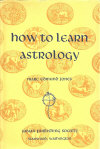
How to Learn Astrology
This wonderfully simple book has long remained the best-selling introductory text by Marc Edmund Jones. When first published in 1941 its method was revolutionary, but its content is the standard astrology used by the vast majority of English-speaking astrologers. Here is an easy way to begin the study, and based on well-tested educational principles. The beginner actually starts to interpret a horoscope before he needs to recognize a single house or planet of sign, or to memorize a single symbol. Although small in compass, the text contains everything essential for the newcomer in astrological analysis. It thoroughly demonstrates the horoscopic elements. (Sabian Publishing Society, 1955). Read it online . . .
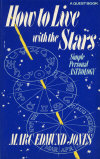
How to Live with the Stars
This is an entirely new kind of book on the transits. In Part One the cycles established by the slower planets are presented so any layman can adjust to them without any astrological knowledge. In Part Two an ephemeris becomes necessary, but in simplified and easy-to-use fashion. In Part Three a horoscope is necessary, but to learn to calculate one need not be too difficult or an astrologer can be asked to prepare it. Part Four demonstrates all these methods in the case of President Nixon and the Watergate scandal which certainly is well known and thus effective for illustrative purposes. (Theosophical Publishing House 1976).
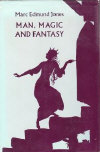
Man, Magic and Fantasy
This delightful excursion into the depths of human consciousness uses the symbolism of well-known fairy tales to supplement philosophy with fantasy. The feminine and masculine principles of life are seen as complementary opposites, manifesting on all levels of reality, including the light-hearted. This book presents the often overlooked story of the domestication of imagination. Purely whimsical realities can be seen in these pages as a key to the appreciation of everyday life. Combining scholarship with imagination, the author presents here a many-leveled view of human nature. (Shambhala Publications, 1978).
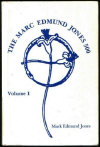
The Marc Edmund Jones 500
During his lifetime, Marc Edmund Jones tape recorded over 500 astrological interpretations of various astrological charts. Those tapes were later transcribed and circulated privately among the members of the Sabian Assembly. In 1973, several newer members of the Sabian Assembly began going back into these transcriptions and, in working through them, thought them of exceptional and continuing value. They suggested a general publication of at least selected ones of them. It was originally planned to publish all of these discussions. This volume contains ten of these transcripts. (ASI Publishers, Inc., 1978).
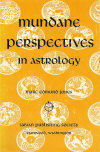
Mundane Perspectives in Astrology
This sequel to The Scope of Astrological Prediction is the expanded dynamic horoscopy covering all its generally accepted techniques of broadened life perspective. The Arabian parts and the geocentric nodes are presented in connection with the natal horoscope. An epochal eight decades of American history are taken to illustrate astrological surrogation or where the horoscope of the ruler of a nation can delineate national events very significantly. Attention is given to actual horoscopes for the nations or any significant aggregates of human individuals. The great planetary cycles, the ingresses of planets into zodiacal signs, together with charts of events or special periods are given basic attention. (Sabian Publishing Society, 1975).
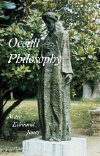
Occult Philosophy
This is one of the most original and comprehensively integrated expositions of occult thinking ever written. Issued in what turned out to be preliminary form in 1924, it gained a highly selective and enthusiastic recognition, but obviously needed a more thorough development together with an elimination of much material which as psychically derived had no scientific validity. As re-written and published in 1948 under its present title, it has served its purpose well. It comprises a clear and lucid presentation of the (1) popular or profane as well as the traditional (2) lesser or lunar and (3) greater or solar Mysteries as these can be defined most practically in modern and everyday terms. The history of occult origins and developments is given in considerable detail, together with a suggestive identification of fundamental modes of thinking. A glossary of some thousand special terms presents an esoteric mosaic of illimitable strands of interrelations. (Trafford Publishing, 2000).
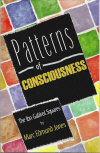
Patterns of Consciousness: The Ibn Gabirol Squares
This book is a posthumously published and edited manuscript written by Marc Edmund Jones. It is based on Ibn Gabirol's 11th century book, The Source of Life. Working with Gabirol's orientation, Dr. Jones developed the comprehensive approach to human development which he built into the extensive lessons used by the Sabian Assembly, the body of students working with Dr. Jones through the years. It marshals a lifetime of study to apply the philosophy of Ibn Gabirol in spelling out sixteen ways of understanding consciousness from the inside, as individual experience. Seeing mankind as immersed in a universe of flux, he provides examples to trace unique individual conscious development from birth to death as well as tracing the development of mankind historically. (Infinity Publishing, 2010).
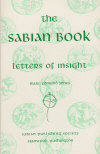
The Sabian Book of Letters to Aspirants
These letters of insight are concerned with the Sabian vision of which the goal is the restoration of the Solar Mysteries. "Solar" is seen to mean a proving from within and "mysteries" an eternal wisdom. The integrity of man and his world is taken to demand an uncompromising respect for personality as the proving within. The wisdom is taken to reveal a totality of existence brought to order in an eternal division of labor between man and his world. (Sabian Publishing Society, 1973). Read it online . . .
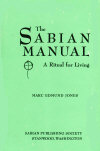
The Sabian Manual
This book is at once a wholly modern introduction to the great esoteric tradition, often identified as the Eternal Wisdom, and a most practical manual for the individual wishing to guide his own aspirations along the lines of the Solar Path. Its pages chart a way of illumination brought to fruition from within the core of man's own personal immortality, and includes the complete rituals of the Sabian Assembly. The account of the evolution of these basic conceptions at the threshold of the Aquarian Age may serve to illustrate the working of the eternal process of Solar Initiation, and in any case establish the text as a useful primer of higher realization for any earnest seeker. (Sabian Publishing Society and Shambhala Publications, 1976). Read it online . . .
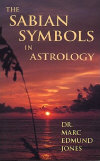
The Sabian Symbols in Astrology
Originally published in 1953, this book is the landmark exposition by Marc Edmund Jones of his world-famous astrological vignettes for all 360 degrees of the zodiac, as brought into manifestation through the visions of Sabian Assembly student, Elsie Wheeler, one day in Balboa Park, California, and recorded at the time on index cards by Dr. Jones. The Sabian Symbols in Astrology explores the miracle of astrology in its illimitable capacity for identification and measure of the pertinencies in everyday reality. It establishes an unexampled means for an understanding of human character through the familiar horoscope and provides a limitless and accurate charting of the cycles of events through the procedures of the dynamic horoscopy. Through these symbols, the imagination is provided with exciting and detailed insight into the significance and nature of almost any human situation or relationship. (Aurora Press, 1993).
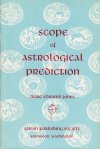
The Scope of Astrological Prediction
This book is the first truly comprehensive exposition of the dynamic horoscopy. Here complete is the technique of the fundamentally important secondary directions, or most familiar form of progression of the horoscope, and in addition there is detailed attention to the primary and tertiary directions. There is also a clear explanation of the solar and lunar returns, when the sun and moon annually and monthly arrive at their original places in the nativity, and of the diurnals established when the ascendant does so daily. Rectification, when the precise hour and minute of birth are unknown or uncertain, is presented with suggested methods of procedure. (Sabian Publishing Society, 1973).
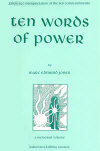
Ten Words of Power
This book presents the Ten Commandments, reformulated for the modern world. The illustrations highlight the ideals these Commandments offer to humankind. Marc Edmund Jones first developed the Ten Words as part of an important ritual in the early days of the Sabian Assembly. Then he built them into the series of essays issued in regular cycle as esoteric instruction for students of the Assembly. These "words" attract the aspirant in the direction of growth, steadiness and self-affirmation. They have the pulling power we feel when we sense a personal potential. This book also provides a biography of Dr. Jones, tracing the creativity which took so many forms during his long life. Designed by the Sabian Assembly as a memorial to Dr. Jones, this book is a doorway into the heart of his message on spiritual self-development. It is an open invitation. (Sabian Publishing Society, 1987).
*This list does not include all books written by Marc Edmund Jones. If anyone wishes a complete list, please request same by e-mail. If you are unable to find any particular title above at your local bookstore or any of the online book merchants, you can probably obtain the book through interlibrary loan at your local library.

Sabian.org





